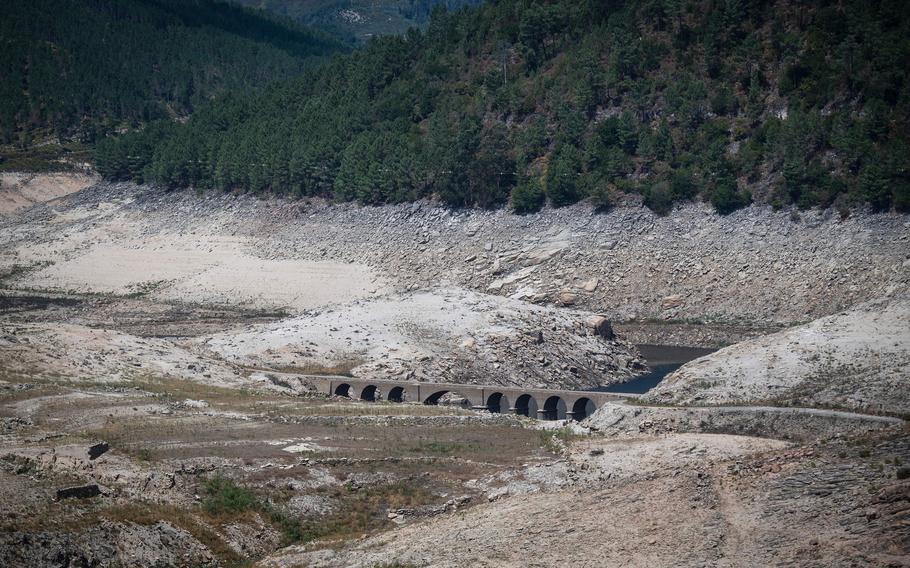
The normally submerged bridge of the one-time village of Aceredo is seen after emerging due to the low water level of the Lindoso reservoir, near Lobios, Spain, on Aug. 25, 2022. (Miguel Riopa/AFP/Getty Images)
(Tribune News Service) — Dropping water levels revealed a massive complex of Roman ruins in Spain as Europe continues to struggle under a record-breaking drought.
Ancient Romans began construction on a military camp in what is now northwestern Spain, along the Lima River in Galicia, in about 75 AD, Spanish researchers wrote in a 2018 study. They abandoned the camp about a century later.
The remaining ruins became submerged after the construction of a dam in 1949 created the As Conchas reservoir, The Guardian reported.
But this summer, all droughts led to Rome.
The ancient camp reappeared on the river bank — its entire ruined complex on display, drone footage posted on Friday by Faro de Vigo showed.
Aerial photographs show a sprawling collection of neatly organized stone structures primarily made of gray-brown cobblestones. What’s left of a wall runs around the smaller structures, water lapping at its edge. A once-grand entrance stands partially collapsed, almost welcoming the river that lies just beyond its doorway.
Pillar bases — their tops long gone — adorn the waist-height rock walls, the video shows. A single archway still stands, defiant against the wearing forces of time and water. Greenery adorns the ruins.
This is Aquis Querquennis, called “A Cida” or “the city” by locals, Ondacero, a local outlet, reports.
In its prime, Aquis Querquennis housed up to 600 Roman soldiers, Atlas Obscura reported. It had multiple barracks, two granaries, a hospital, temple, and thermal baths from the area’s natural hot springs. Romans at the camp would throw offerings of spiritual significance into the hot baths, Atlas Obscura reported.
Centuries later, all of Aquis Querquennis had been thrown under water. The full complex emerged as water levels in the As Conchas reservoir fell to 49% capacity, Faro de Vigo reported in early August.
Spain – like much of Europe – has struggled under above-average temperatures and below-average rainfall, causing a heat wave and drought, BBC reported. Almost two-thirds of Europe is under drought warning or alert conditions, according to the European Drought Observatory.
The region’s current drought, amplified by human-induced climate change, appears to be the worst one in at least 500 years, CNBC reported, citing meteorologists.
As a result, “nearly all of Europe’s rivers have dried up to some extent,” BBC reported on Aug. 24, citing an EU report. Pieces of history – “hunger stones,” World War II shipwrecks and “megalithic monuments” – have surfaced in these drying waterways.
Unfortunately, the drought is far from over, BBC reported, with the hot and dry conditions likely continuing until November. Drought conditions are expected to worsen in Belgium, France, Germany, Hungary, Italy, Luxembourg, Moldova, the Netherlands, northern Serbia, Portugal, Romania, Spain, Ukraine and the United Kingdom, CNBC reported, citing the EU report.
Aquis Querquennis is about 300 miles northwest of Madrid, near the Spain-Portugal border.
———
©2022 The Charlotte Observer.
Visit charlotteobserver.com.
Distributed by Tribune Content Agency, LLC.